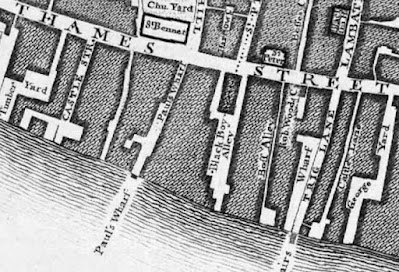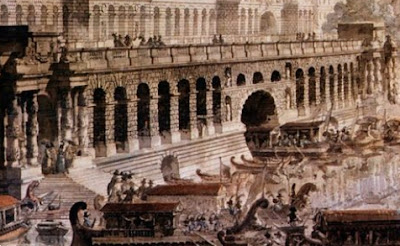Embankment Ends : Docks Developed
Historically, the life-blood of London was to be found in docks and wharves on the north back, lining the river with bustling trade all the way from Somerset House to the Tower of London and beyond. By the 19th century much of this area was run down and sordid; it spoiled the view from the Duke of Westminster's posh housing and office blocks that lay along the line of The Strand.
So the grand plan was to build an embankment which would protect the property, remove the grot and "contain" the unruly Thames!The thick black liner shows the concept of the section from Somerset House to Blackfrairs road bridge.
Started in 1862, the Victoria Embankment starting from Millbank on the north bank was primarily designed by Sir Joseph Bazalgette with architectural work on the embankment wall and river stairs by Charles Henry Driver. It incorporates Joe's revolutionary interceptor sewer, and an underground railway over which a wide road and riverside walkway were built and run today, shored up by the sturdy retaining wall along the tidal River Thames.
Below, a cross section of the Embankment at Charing Cross station.
Below we see the work outside Somerset House, the garden of which abutted the river's edge.It was a massive and revolutionary development ...
Below we see the work outside Somerset House, the garden of which abutted the river's edge.It was a massive and revolutionary development ...
Bazalgette's scheme reclaimed 22 acres of land from the river and produced a superb road, railway, sewer and walkway system for Londoners. It also provided a space for London's trams, running on "reserved" track ...
Here is Somerset House today!But at Blackfriars road bridge, the embanking ceased to embank!The main drag veered sharp left and then offered a right fork to take you via Queen Victoria Street and on to "The City" and The Tower of London. Upper Thames Street was a more lowly road which gave access to the wharves and warehouses and to several inlets from the main river. One of these (under the "E" of "Queens" in the above map) was Puddle Dock.
It is clearly labelled on the 1746 map.The original St Andrews-at-the-Wardrobe was lost in the Great Fire of London, but rebuilt in 1695 and still stands.Queen Victoria Street (like Queen Victoria herself) did not exist in 1695, but (Upper) Thames Street was the "collector" road which served the riverbank businesses. A more modern street map still shows the Puddle as being wet!Obviously the dock is no longer wet and formed the terminus of the Kings Ferry commuter coaches to Kent.We will conclude this tale in tomorrow's blog.
Meanwhile In TSY Towers ...
... the X57 (withdrawn from 9th September) remains on display ...... as does the old 257 ...... which gained a much improved service from the same date.
... the X57 (withdrawn from 9th September) remains on display ...... as does the old 257 ...... which gained a much improved service from the same date.
Needless to say, the sainted Traveline, managed by TSY, is also wrong! You can still catch an X57 from Sheffield to Manchester.Thankfully the truly wonderful Derbyshire, working with minimal staffing and even more minimal budget, can get it right - and in good time too.
IT'S ALL ON LINE
Hornby's Oddity Collection
Having recently released their OO model of the LNER turbine powered loco ...... the company has now announced that it will be making the LMS "Turbomotive". This was a much simpler project that the L N E R 10000 which was a totally new locomotive. 6202 was a normal "Princess" class, greatly modifoed. In simple terms (it wasn't quite that simple!) the cylinders were replaced with a turbine.When the turbine failed, it was decided that the experiment was over and 6202 (by now 46202) was re-rebuilt as a conventional engine. Sadly she did not last long as she perished in the horrific Harrow and Wealdstone crash in 1952.In OO gauge, 10000 will set you back just over £241 whist 6202 comes in at £266.
Yikes!
Final Puddle blog (and extras) : Friday 14th January

























The 257/X57 is actually listed on the TSY website and refers people to the Hulleys website for details, presumably Hulleys haven't submitted their timetable electronically to them? https://travelsouthyorkshire.com/en-gb/newsupdates/service-changes#sheffield
ReplyDeleteNo turbine's on the LNER "Hush-hush" loco - but a very high-pressure water-tube boiler.
ReplyDelete